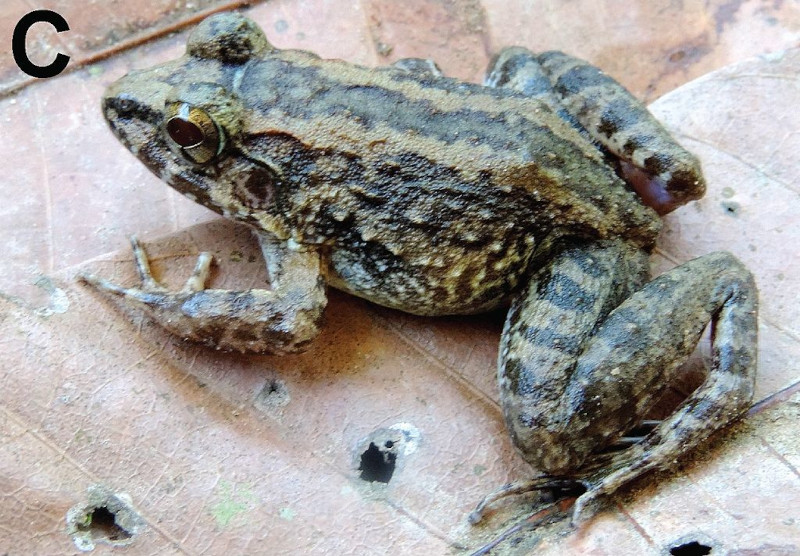
Limnonectes larvaepartus Facts
- The recently discovered marvel of Nature and evolution known as the Limnonectes larvaepartus truly represents a highly unique species of frog. This newly recognized and unquestionably remarkable animal does not yet even possess a common name, unfortunately.
- The amazing creature received its first scientific recognition in 1994, though under a notably different, temporary designation. Its first formal description and naming took place in he year 2014, however. That action occurred at the hands of a group of three herpetologists.
- Astonishingly, this incredible amphibian also represents one of only four known varieties of frog to develop fang-like teeth. Currently 6,455 known extant species of frog currently exist across the globe. This animal now represents one of only twelve to reproduce internally.
- To further add to its distinctiveness, it also constitutes the only known frog on earth to not only conceive internally, but to actually give birth to fully developed tadpoles. All of the other species of frogs known to science that also give birth to live young deliver froglets.
- The IUCN now lists the Limnonectes larvaepartus as Least Concern on its Red List of Threatened Species. That status may soon change, though, since its numbers seem to be diminishing. It faces many threats to its continued existence, including that of climate change.
Related Articles
Limnonectes larvaepartus Physical Description
Indisputably, the astounding Limnonectes larvaepartus immediately captures the attention and interest of those individuals fortunate enough to spot one. It does not do so due to any especially impressive physical stature, however. That’s true given the fact that it ranks as a very small frog.
The amphibian also follows a pattern of development shared by countless other fauna around the world. That’s the fact that it displays a certain degree of the physiological characteristic of sexual dimorphism. In its specific case, though, this evolutionary trait manifests itself in terms of size.
Overall, mature adults of this remarkable creature attain an average body length equaling approximately 1.5 in (3.8 cm). Females tend to be slightly larger than their male counterparts. It also remains an extremely lightweight animal. A mean body mass only measures about 0.18 oz (5 gms).
These statistics combined lead to another mild example of gender-based difference among specimens of this natural wonder. That’s true since, even though the males reach shorter lengths, their masses roughly equal the females. This results in the males having a stouter body shape.
Otherwise, males and females of the Limnonectes larvaepartus tend to present the same general outward appearance to the observer. Intriguingly, however, this trait also has a tendency to vary significantly among individuals. This does so completely independently of the sex of the individual.
The upper portions of the body of the amphibian vary in color to the greatest degree. This portion generally develops as either a brownish gray, golden tan or reddish-brown in coloring. Its underbelly, though, most frequently develops as either a light cream-colored or yellowish shade.
- Kingdom: Animalia
- Phylum: Chordata
- Class: Amphibia
- Order: Anura
- Family: Dicroglossidae
- Genus: Limnonectes
- Species: L. larvaepartus
Limnonectes larvaepartus Distribution, Habitat, and Ecology
The remarkable Limnonectes larvaepartus evolved as indigenous to an extremely restricted portion of the surface of the earth. Exactly where that native zone of habitation lies, therefore, will likely elude most of you. That’s because it developed as endemic to only one small location in Asia.
The stunning island of Sulawesi, located in Indonesia, represents that singular habitat range for this marvel of evolution. Even there, however, it only lives on the Northern Peninsula and the western margin of the Central Core region. So fat, it remains unknown if it ever lived beyond this region.
The amazing amphibian demonstrates very specific preferences in terms of where it chooses to make its home. The very nature of that habitat, unfortunately, makes detailed study of the impressive animal quite difficult. The sole living area of the marvel consists of a very dense jungle.
Even there, however, the Limnonectes larvaepartus still only appears within a very specific type of local environment. To the current knowledge of scientists, the isolated animal only chooses to make its home near streams, and even then only in the more mountainous regions of its island home.
The precise dietary habits of this wonder of Nature haven’t yet been determined by researchers, primarily due to the inherent difficulties of studying it in sufficient detail. Like its relatives, though, adults feed on the various many small insects species prevalent within its zone of habitation.
After mating, females of the species typically produce about 100 eggs. How the surprising creature achieves internal reproduction actually remains a complete mystery to herpetologists, however. This enigma occurs due to the fact that males actually possesses no discernible reproductive organ.
Species Sharing Its Range
Check out our other articles on Native North American Mammals, Green Iguana, Tristan da Cunha, Common European Viper, Orange-belted Bumblebee, Holy Ghost Orchid, Spiny Flower Mantis
